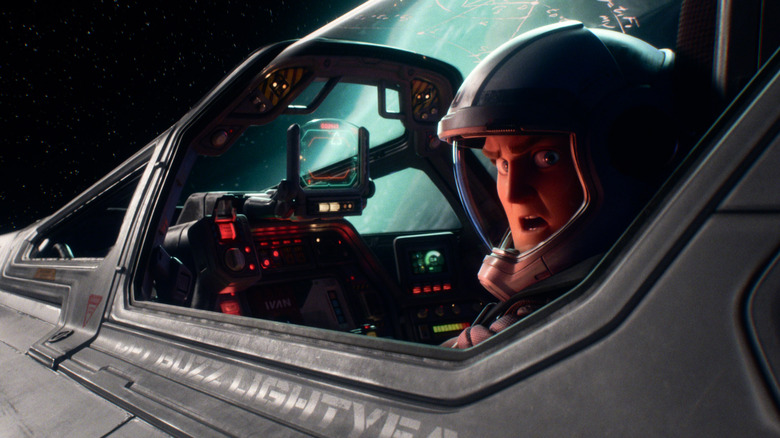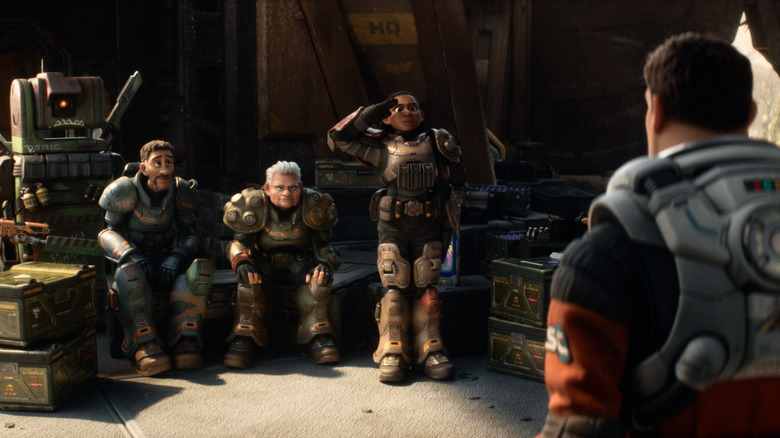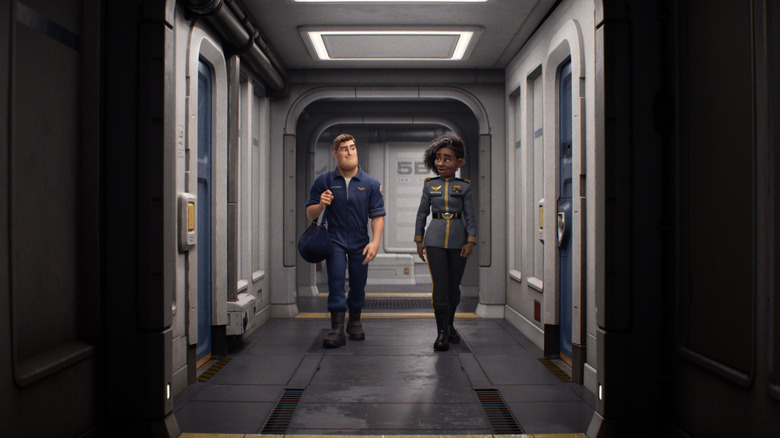Lightyear Director Of Photography Jeremy Lasky On Crafting Pixar's Big Sci-Fi Adventure [Interview]
When looking at any art form or craft that requires a lot of moving parts to bring the final project to life, a common saying used to describe that collective effort is "it takes an army." Movies are an exceptionally apt example of that phrase in action. Yes, the director is the position through which this army flows, but it really is a collaborative undertaking between a whole lot of people. And if the director has a top general, it would probably be the director of photography. In the case of Pixar's latest endeavor "Lightyear," that duty fell to Jeremy Lasky, a seasoned veteran not just of animation, but of this studio.
Lasky's work with Pixar dates back to "A Bug's Life," when he was working in the animation department before he eventually moved up to become the DP for "Cars," a position he's also held on "Wall-E," "Toy Story 3," "Cars 2," "Finding Dory," and "Cars 3." That is certainly an impressive resume, but what does his job actually entail? What is it like holding such an important position on a gigantic animated film such as this? In this case, it's a sci-fi adventure very loosely set within the "Toy Story" universe based on Buzz Lightyear — but the "real" Buzz, not the toy.
I recently had the good fortune of speaking with Lasky ahead of the movie's release this summer. We discussed what exactly he does, how it differed from animation to live-action, and whether or not he would ever want to step up to the plate and direct a full movie for Pixar in the future.
"It means I can make a lot more mistakes"
I've been doing this a while and I've interviewed quite a bit of people and I actually think you have the distinction of being the first director of photography I've ever interviewed, oddly enough.
Excellent. Let's do this.
Because sometimes I just use this for my own edification, what would you say the job of a DP is? What do you do?
Sure. Great question. If we think of a DP, regardless of the film, regardless of the media, regardless of the genre, my job is to lead this team that figures out, with the director, with the editor, what is the staging and camera plan for the movie? Meaning, how is the film shot? Where is the camera? Is the camera moving? What kinds of lenses are we using? How are we going from one shot to the next? What's the visual style of the film in terms of what we see? And in animation, we're also looking at how are the characters staged? How do they relate to one another? Where are they in the set?
A lot of times in live-action, you have actors come in and they go through a blocking process with the director, and the DP is finding an angle that works. Since we don't really have actors on set, we have animators and they come after us, layout, our team is figuring out where those characters are and what their marks are. Buzz is going to come in, he's going to turn to his friend Sox, and he's going to sit down on the bed. They're going to have a conversation. Sox is going to run off, Buzz is going to follow him into the kitchen, or whatever the thing is. And do we like that? Should Buzz be sitting on the bed? Should he not be sitting on the bed? How does that work? That's the outline of what a DP does.
You mentioned the broad terms of what a DP does in cinema in general, but how does it compare doing this for a gigantic scope animated film versus doing it for a live-action film? How does that change the scope of your job?
It means I can make a lot more mistakes. For example, live-action film, you make your shots, you film whatever you're going to film, and it goes to the editor and boy, hopefully, all that stuff works and it cuts together. Maybe if you're lucky, you get a re-shoot day or a couple re-shoot days or whatever. But man, it's really up to you to make sure everything is correct. Here, it's much more collaborative, it's much more iterative. For example, we'll build a bunch of shots and kind of assemble how we think the sequence could play. We'll build some alternative cuts or different blocking, different staging, maybe we'll try a camera like this for this shot, instead of this. It all goes to editorial, but we work super close with whoever's editing that scene. And sometimes it's another editor, before Tony Greenberg, our lead editor, takes it.
So as they're looking at it, we look at it with him and anyone can say, "I don't think this transition from this shot to this shot's working. Do we have anything else? Can we film something else? Yes. Great. Actually, you're right. This camera feels too fast. Let me go back and fix that and send it on." Or even now we're doing some lighting reviews, it's like, "I don't think Buzz is as in focus as he should be." "Okay, good. I'm going to go fix that. It's going to take me two minutes and then you guys can re-render it." Rather than, "Shoot, that whole roll was out of focus. I guess we're going to have to get Chris Evans back. Is he free? He's not a busy guy, right? Can we do that? I know it's my fault. That's okay. Right?" I would never work again. This way, we can kind of do whatever we want.
We also can make any equipment we want. You want a crane? I got you a crane. We want to do a drone shot, a dolly shot, whatever, we can do it. All of that freedom comes with this extra responsibility though, of not going to town and doing anything you want. You still have to have the respect for the craft, or the understanding that when you move a camera, the whole image moves. Everything moves at one time. Audiences are so sophisticated, even though they may not know it, on what a film looks like and how cameras move. Yes, you can do a bunch of stuff in CG and live-action too, but it needs to feel weighty. It needs to feel like it's a real presence in the shot, especially in CG. We go to all these pains to make sure it feels real enough that you can suspend your disbelief for 90 minutes and go, "Yep. I'm watching Buzz Lightyear in space on this planet fight Zurg." As soon as that camera starts to do something strange, I'm questioning everything. As an audience member, I'm like, "Well, but that's not real. Wait a minute." Now I'm not following Buzz's adventure anymore. I'm out critiquing the film on my own.
"I really think of it, not as a 'Toy Story' anything, but as this is a movie about Buzz Lightyear"
I guess we should talk a little bit specifically about "Lightyear." Even within the Hollywood franchise obsession era, this is a really unique idea for a film, taking, not just a spin-off of "Toy Story," but this hyper-specific type of spin-off, if you want to call it that. Because you've been working at Pixar for a while, how does working on this compare to everything else you've worked on?
I loved it. I mean, there's always something about all the films I've worked on that I've said, "Oh, this was really great." Or "I learned this." Or "I'm so proud of what we did with this." And "Lightyear" is no different. I really think of it, not as a "Toy Story" anything, but as this is a movie about Buzz Lightyear. And Buzz Lightyear, the character that we've made, not the toy that I remember seeing "Toy Story" in college and saying, "Best thing ever." Or the "Toy Story 3" that I was the DP on. It's just different. It just feels like, "Wow, I get to hang out with my friends and make this super awesome sci-fi adventure." And we get to make it look unique. We get to try all these things as film geeks we love and we get to put them in this movie. Yeah, I guess lots of people are going to see it, and I guess it features a character that's beloved. But okay, well, we're just going to make the movie as good as we can. We're going to make the best movie we can and hope that other people like it, too.
What happens a lot within the ranks of Pixar is people do other jobs for a long time and then they direct a little something, and then they end up directing a feature. Is that something you would like to do? Or are you happy where you are, sort of doing your thing?
I really enjoy this. I mean, I really, really do. I've done a little directing on some small things, some small projects, and this was the most fun I've had at Pixar so far — and I've had a lot of fun. This movie was really great. We've kind of broken down a lot of the walls on this film in terms of what roles people have and how the departments work together. It's just a blast. We talked a little about pulling in animation, pulling in all these other teams with us. It's the closest I've had to feeling like we're all on a set since being on a real set. It's just such a great feeling. I could go on and on. It's not that I don't want to direct, it's that right now the opportunity is I got to help one of my closest friends make this awesome movie that I really love. It's hard to beat that. It's hard to get away from that. That was really for me, so great. What a great way to spend the last two-plus years.
"Lightyear" is set to hit theaters on June 17, 2022.


